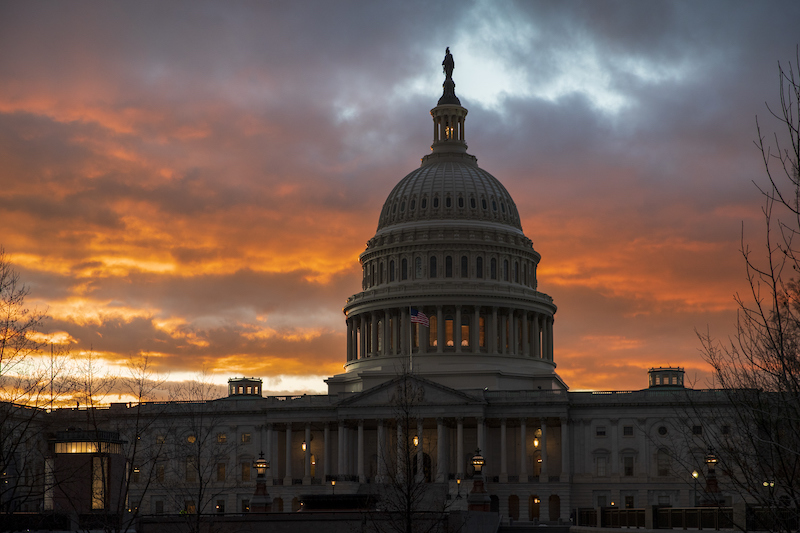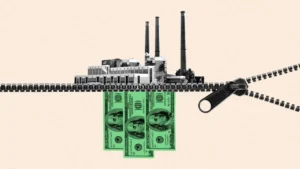It’s the Green New Deal or Else
Critics maintain that the legislation is too radical to be enacted into law. The climate science suggests it may not be radical enough. The Capitol seen at sunset in Washington, D.C., in January. (J. Scott Applewhite / AP)
The Capitol seen at sunset in Washington, D.C., in January. (J. Scott Applewhite / AP)
I suppose we all owe UCLA economist and Hoover Institution senior fellow Lee Ohanian a debt of gratitude for telling us how it is. The “free market” propagandist recently took to the pages of The Hill, a Washington, D.C., journal for political insiders, to explain that the holy laws of economics dictate that humanity must consent to its own extermination. In a piece titled “The Green New Deal is a Pipe Dream,” Ohanian drowned climate activists’ overheated dreams of ecological salvation in the icy waters of bourgeois reality, arguing that the proposed legislation’s advocates are, in fact, nefarious, big-government “command-and-control” zealots—eco-Stalinists—who want “to impose their social and economic preferences on others at an extravagantly high economic cost.”
Ohanian described the Green New Deal’s goal of net-zero U.S. carbon emissions in 10 years as an “infeasible” aim that demonstrates a failure “to understand basic cost-benefit analysis.” If that weren’t enough, the Hoover fellow noted that “the GND would be extremely expensive” and that America lacks “the technological know-how” to reach zero carbon emissions. Ohanian further pleased the Hoover Institution’s big-business sponsors by adding his judgment that the Green New Deal’s promise of a living wage will make workers lazy and unproductive. No such promise can be fulfilled today, “when jobs can be easily offshored, outsourced, and automated,” he pronounced.
Now that we understand these economic realities, we can prepare—without rebellion, with calm acceptance and within the limits of our stagnant incomes—for our coming extinction. Onward with the coming macroeconomic ecocide.
Except, wait. Hold on. Maybe Ohanian is full of petroligarchic crap. Maybe there’s still hope for the species after all.
He is, and there is.
It’s simply not true that we lack the technological expertise to achieve zero carbon emissions. Writing for Scientific American, Stanford engineering professor Mark Jacobson and University of California at Davis research scientist Mark Delucchi have shown repeatedly over the last decade that humanity could convert to a completely renewable energy-based system by 2030 if nations employ technologies vetted by scientists rather than those championed by private industry.
In their state-level analysis, which focuses on New York and California, Jacobson and Delucchi conclude that wind turbines, water machines, solar installations and other green technologies are affordable and available for rapid utilization. “The main obstacles are political and social—getting politicians onboard,” Jacobson told a leading science reporter six years ago. “There are always naysayers who think it’s pie in the sky, that we’ll never get there. And there are people who are tied into a certain industry who push back the most.”
The Green New Deal would cost a lot of money, Ohanian insists. What, like the giant tax breaks that Donald Trump and Congress gave the richest 10th of the 1 percent and their corporate allies, adding $2.2 trillion to the national debt (equal to $17,500 per household)? Like our subsidies for the military-industrial complex, which costs taxpayers $700 billion today and is projected to cost $972 billion by 2024, despite having the largest carbon footprint of any single institution on earth? Like the $204 billion spent on advertising in the U.S. last year to push a maddening surfeit of consumer products, many, if not most, designed in accord with the ecocidal principle of built-in obsolescence?
From 2014 through 2018, the global capitalist system spent $2.72 trillion on advertising alone. Imagine where we’d be on the path to slowing climate change if all that money had been spent on wind turbines, water machines, solar installations, sustainable agriculture, reforestation and green retrofitting, infrastructure and regional planning. There’s more than enough money to fund training to close the skilled heating, ventilation and air-conditioning-worker gap.
Meanwhile, Ohanian’s classist notion that workers will become indolent and inefficient if they are guaranteed a living wage is a Dickensian old wives’ tale. Productivity positively—not negatively—correlates with a living wage. And how does Ohanian think workers are supposed to lead dignified lives without one? Are millions of young adults supposed to live with their parents indefinitely or rely on food pantries and homeless shelters to get by while working full-time jobs?
Outsourcing, offshoring and automation are not without solutions, such as government and union restrictions; capital controls; green government jobs programs to absorb technically displaced workers; international efforts to raise wages and labor standards abroad; and guaranteed national incomes. Much of this is addressed in economist Robert Pollin’s important book, “Greening the Global Economy,” which advances “just transition” polices that include “solid pension protections, re-employment guarantees, as well as retraining and relocation support for individual workers, and community-support initiatives” for communities negatively affected by the suspension of fossil fuel extraction and burning.
Here’s a true pipe dream (maybe we should call it a “pipeline dream”): the continuation of a decent human existence even for rich nations comparatively sheltered from the worst consequences of climate change.
In 2008, James Hansen, then head of NASA’s Goddard Institute for Space Studies, and seven other leading climate scientists reported that we would see “practically irreversible ice sheet and species loss” if the planet’s average temperature rose above 1 degree Celsius (1.8 F), thanks to carbon dioxide (CO2) in the atmosphere reaching 450 parts per million (ppm).
When the report was published, CO2 levels were at 385—“already in the dangerous zone” according to Hansen and his team. They warned that deadly, self-reinforcing “feedbacks” could be triggered at that level. The dire prospects they warned of included “ice sheet disintegration, vegetation migration, and [greenhouse gas] release from soils, tundra, or ocean sediments.”
The only way to assure a livable climate, Hansen and his colleagues warned, was to cut CO2 to at least 350 ppm.
Here we are, 11 years later, having blown past Hansen’s 1 degree Celsius red line since 2015. We currently stand at 410 ppm, the highest level of CO2 saturation in 800,000 years. The latest climate report of the United Nations Intergovernmental Panel on Climate Change (IPCC) reflects the consensus opinion of the world’s leading climate scientists. It tells us that we are headed to a temperature increase of 1.5 degrees Celsius (2.7 F) in the next 12 years. Failure to dramatically slash emissions between now and 2030 is certain to set off catastrophic developments for hundreds of millions of people, the report warns.
The IPCC finds that at our current pace, we are headed for a 3- to 4-degree Celsius (5.4 F to 7.2 F) temperature increase by the end of century. That will mean a planet that is mostly unlivable.
It gets worse. Numerous climate scientists have indicated that the IPCC’s findings are excessively conservative. That’s because the institute deletes and downplays research demonstrating the likelihood that irreversible climatological tipping points could arrive sooner than expected. Among the reports pointing to these conclusions is a recent NASA-funded study warning that the unexpectedly abrupt thawing of permafrost could release massive volumes of CO2 and methane within a few decades.
Earth, biological and social scientists are increasingly raising the specter of climate-driven human extinction in the not-so-distant future. In vast swaths of the world, across much of sub-Saharan Africa, India, the Middle East, Latin America and Southeast Asia, climate catastrophe is already underway.
Conservative though it may be, the U.N. report is no whitewash. It gives us 12 years to drastically slash greenhouse gas emissions or face catastrophic consequences. It also calls for “unprecedented changes in all aspects of society” to drop global CO2 emissions 45 percent below 2010 levels and 60 percent below 2015 levels by 2030. We need to hit zero by the midcentury point, the IPCC says, and we cannot do that without radically and rapidly reducing our energy consumption.
Cost-benefit analysis? The Green New Deal is, if anything, insufficiently radical. It does not go to the full class-rule taproot of the many deadly ecological rifts (the climate crisis is only the most urgent) opened by capitalism’s relentless, totalitarian drive to commodify everything on earth. Progressive-Democrat Green New Deal advocates have yet to join serious ecosocialists in calling for green investments to be garnered from massive reductions in the U.S. military budget, which eats up more than half of federal discretionary spending and sustains a global military empire that is the world’s single largest institutional carbon emitter. The Green New Deal’s sponsors have yet to call (as they will have to if they are serious about environmental reconversion) for their program to be funded and protected from capital flight by the nationalization of the United States’ leading financial institutions.
Still, at least Green New Dealers are talking seriously about the benefit of a livable earth. It seems like society might want to be ready to absorb significant costs to achieve the continuation of the species. Professor Ohanian should write the environmentalists’ maxim 500 times on a UCLA chalkboard: “There are no jobs on a dead planet. There is no economy on a dead planet.”
Zero carbon emissions by 2030 (or even 2040) is a grandiose goal. But guess what? Now is precisely the time to aim sky high on ecology and way low on carbon release. How much are we willing to pay for human survival? Do environmental calamity and the real risk of extinction count as “extravagantly high costs”? When might we be willing to achieve the not-so-fringe benefit of continued existence by confronting the totalitarian “command and control” imposed on all of us by big carbon capital’s social and economic preference for short-term private accumulation and profit over the longer-term common good—over any kind of decent future for human beings and other living things?
Your support matters…Independent journalism is under threat and overshadowed by heavily funded mainstream media.
You can help level the playing field. Become a member.
Your tax-deductible contribution keeps us digging beneath the headlines to give you thought-provoking, investigative reporting and analysis that unearths what's really happening- without compromise.
Give today to support our courageous, independent journalists.









You need to be a supporter to comment.
There are currently no responses to this article.
Be the first to respond.